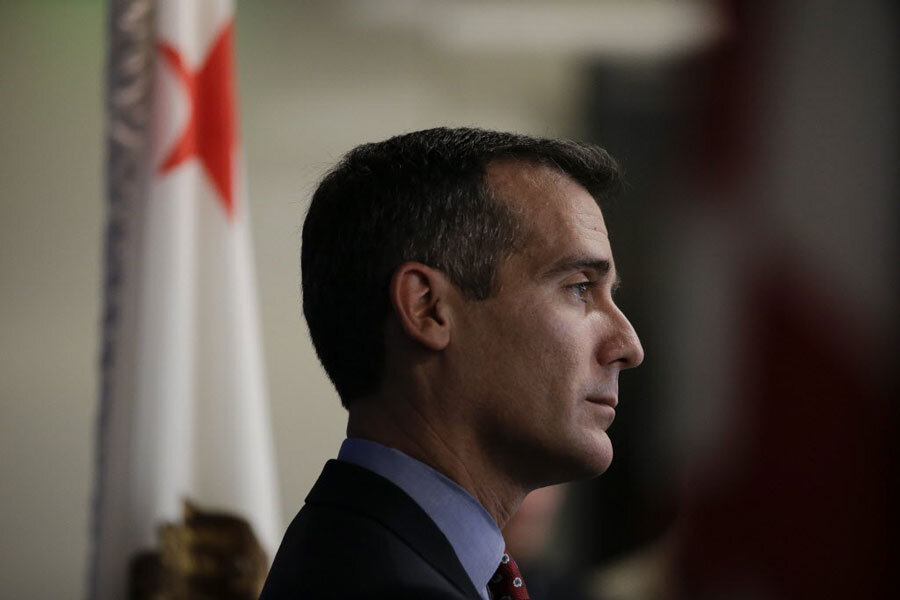Los Angeles considers most sweeping earthquake readiness plan in city history
Loading...
| Los Angeles
How prepared is Los Angeles for a major earthquake?
On Monday, the city’s new mayor, Eric Garcetti, handed southern Californians a wake-up call in the form of a year-long study his office commissioned to answer that question.
The findings are sobering, suggesting thousands of people would die in the most vulnerable wooden and concrete structures unless they are strengthened to withstand a major seismic event.
The mayor is calling for mandatory retrofitting of buildings built before 1980, in what some observers have called the most sweeping earthquake safety plan in the history of the city.
“These responsibilities have been shirked for far too long. That stops now,” Garcetti said Monday.
The study’s findings were punctuated Monday by being delivered in the shadow of one of the biggest fires the nation’s second-largest city has experienced. Nearly an entire downtown city block was consumed by a blaze that began early Monday morning and shut down the heart of the city for most of the day.
“We all saw the fire this morning. Imagine 1,600 at the same time,” said US Geological Survey seismologist Lucy Jones, who serves as Mayor Garcetti’s science adviser and directed the study. Fires from broken gas lines are a major danger in quake zones.
Certainly, earthquakes are not a new threat to Los Angeles, and city preparedness is a subject that comes up after every major disaster. But the new mayor appears determined to set his seal on the city’s future and, despite costs estimated in the billions, to take a proactive approach to a longstanding issue.
“Earthquake policy has more often than not been developed in the immediate aftermath of a major earthquake. And even then, momentum quickly died out, leaving grave vulnerabilities behind. Today, Los Angeles is addressing our greatest earthquake vulnerabilities proactively and strategically,” Garcetti wrote in a blog post Monday. “We cannot afford to be complacent.”
In addition to such proposals as solar powered wi-fi hotspots that would be available during a power failure and a plan to create an alternative water supply for firefighters, his office has laid out a robust plan targeting the most vulnerable concrete and wooden structures. Owners of the estimated 15,000 wooden structures would have five years to complete the retrofitting. Owners of the estimated 1,500 concrete buildings would have a 25-year horizon.
The mayor’s proposal would need to be approved by City Council. Costs to retrofit the buildings would be borne by owners, who likely would pass along costs to their tenants. And questions remain about how the regulations would be enforced.
Cost is the major stumbling block to readying the city for a major event: Estimates to retrofit a single concrete office building run up to $1 million dollars, while a so-called “soft structure,” such as the two- and three-story wooden apartment buildings that sit atop wooden posts, can run between $60,000 and $130,000 each, according to the Los Angeles Times.
Garcetti has proposed a variety of funding strategies – from low-cost loans to a bond measure – to free up funds to help landlords shoulder the cost of a retrofit.
Disaster preparedness experts suggest other strategies that could help. In some cases, a crawl, walk, run approach could make the difference for owners who cannot afford to empty an entire building for a complete retrofit all at once.
“Can you do it in pieces or stages? Do you have to do it all at once?” asks Bob DiLossi, director, Crisis Management and Testing for Sungard Availability Services, a firm that advises businesses on disaster preparedness. He suggests landlords can present options to building occupants and work on a plan together.
Not every building requires the same level of work, points out Jim Mynott, vice president of Design Management, for the construction firm McCarthy in the southern California division.
“It might be something as simple as application of strapping to make a building more resistant,” he says.
A more serious issue may be the ability to monitor the upgrades.
“Long story short: How are they going to enforce the building code upgrades?” he asks.
But, says the mayor, the work must be done. The city’s economic viability may depend on it, he says. A hobbled Los Angeles also could hurt the overall US economy, because, in addition to being the country’s second-largest city, it is also home to the nation’s largest container port.
The city has no choice, suggests Washington media consultant Scott Sobel. “Think of the second-guessing after Katrina,” he says via e-mail.
Los Angeles and California preparedness issues “are part of the overall deteriorating US infrastructure malaise – some politicians must take unpopular positions and spend money,” he adds.
The stakes are getting higher with every natural disaster, adds Chris McIntosh, emergency management industry manager for Esri, an international firm that supplies geographic mapping software that tracks resource allocation.
“These natural disasters are not going to stop happening,” he points out, noting that hurricane Andrew stood for years as the most expensive in US history. But, since then, massively expensive events have multiplied, from hurricane Katrina to superstorm Sandy.
Unless politicians begin to mitigate damage before it occurs, “these things are ultimately going to have a detrimental impact on our nation as a whole.”







